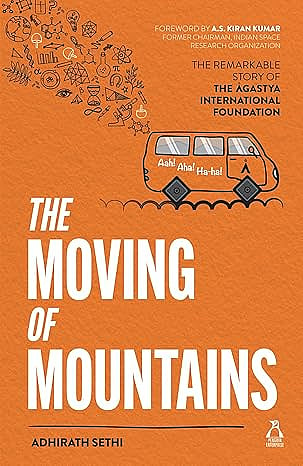Classroom Revolution

Indian education is plagued by ‘Answerism’, rote-based learning directed towards filling examination sheets with the right answers. Add ‘Credentialism’, where academic certificates or degrees count for much more than the learning they should represent. Together, these -isms stifle curiosity and inquiry, which should be at the heart of learning. If encouraged and nurtured in childhood, they set one on the path of life-long learning.
The Moving of Mountains is the story of Agastya International Foundation, a movement to encourage curiosity and critical thinking among the children of India. The title has its literal origin in the Andhra hilltop that was shaped to build the central Agastya campus. As a metaphor, it suggests the challenges of setting a new course in the centralised structure of formal education.
Written by Adhirath Sethi, an Agastya trustee, the book begins with the meeting of minds and intent of people whom he describes as A Banker, A Broker, and Three Wise Men. The prime mover was the banker, Rama Prasad ‘Ramji’ Raghavan, who moved from a banking career in London to his native place Bangalore in 1998. With his co-founder, the broker F Mahavir Kumar, Ramji moved with incredible speed. Agastya was registered in 1999, and by the turn of the century, Agastya had acquired 172 acres of land near the town of Kuppam.
Fund-raising at scale is never easy; while it would be several years before the first buildings came up on the campus, the Agastya think-tank was busy giving shape and form to science experiments for school children. One summer, my son and I ran simple experiments for children in remote Ladakh villages. We had no training or qualifications, yet the enthusiasm we generated was hugely energising. Agastya’s intellectual contributors, in contrast, were heavyweights from India’s leading scientific institutions and corporate organisations, and I can imagine the quality of stimuli they developed for young minds.
2025 In Review
12 Dec 2025 - Vol 04 | Issue 51
Words and scenes in retrospect
A seminal science fair in February 2000 had been planned for 500 children, but generated a wave of enthusiasm that looked like it was attracting 5,000. The trained staff was going to prove hugely inadequate. From this impending crisis was born the concept of student volunteers to run the experiments. Over two days, the Agastya team trained a hundred students to virtually run the fair.
“They had stumbled upon something spectacular”. The success of peer-to-peer learning laid the foundation for much of Agastya’s work over the next two decades, where enthusiasm and desire proved more effective than degrees in teaching.
The campus could wait. By 2002, Agastya had its first mobile science lab, taking science to schools, rather than bringing children to Agastya. In time, the campus would develop landmark buildings, thanks to support from major philanthropists like Rakesh Jhunjhunwala, but it was the mobile labs that allowed it to spread its reach across Andhra, northern Karnataka, Maharashtra, and eventually to Bihar and reaches of northern India. Backstopping these labs was a continuously evolving, rigorous process of recruiting, training and evaluating teachers.
Agastya’s work has reached twenty-five million schoolchildren, and two lakh teachers. Research affirms that these interventions shape a shift from passive to active learning. “By 2008, Agastya’s name had become synonymous with hands-on education”. The National Knowledge Commission asked Agastya to develop a plan to extend their model across the nation. “Budget constraints, however, prevented the plan from becoming operational.”
In the book, I sense a disappointment that Agastya could not do more. Organisations like Agastya are driven by the depth of their desire to affect change. When their work succeeds, they crave the national scale that government mechanisms can deliver. This is always fraught with policy shifts, political compulsions, and the resistance of deeply entrenched systems to external change agents.
Deep work will find its way into the world, affect change in a million little ways that cannot be enumerated. In the doing must be found the satisfaction. To extend the mountain metaphor, change at a sub-continental level will be glacial.

